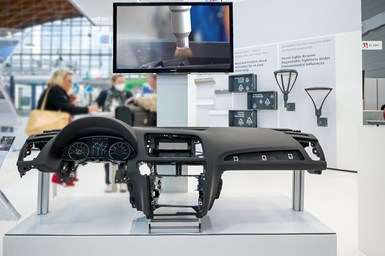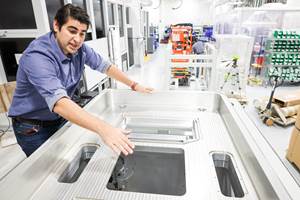Plasmatreat Openair-Plasma Offers Safe Surface Cleaning, Activation
The atmospheric plasma solutions include high-efficiency plasma cleaning, activation and nanocoating of surfaces.
Even large components, such as an automotive dashboard, can emerge from the 3D printer and then be bonded, painted or printed — all possible through pretreatment with Openair-Plasma. Photo Credit: Plasmatreat
Plasmatreat’s Openair-Plasma processes are designed to optimize additive manufacturing (AM) by significantly improving the quality of components while also reducing the manufacturing company’s carbon footprint. The company says atmospheric pressure plasma pretreatment is one of the most efficient plasma processes for cleaning, activating or coating plastics, metals, glass, recycled materials and composite materials.
Activating the surface with Openair-Plasma enables environmentally friendly printing and painting without resorting to conventional flame treatment or chemical pretreatment. In comparison to low pressure plasma technology, no special chamber system is required when Openair-Plasma technology is used. During ultrafine cleaning with Openair-Plasma (plasma cleaning), surfaces are gently and safely cleaned of release agents and additives, and sterilized (plasma sterilization), while plasma activation makes later adhesion of glues and coatings possible. By using the nanocoating PlasmaPlus (plasma coating), functionalized surface characteristics can also be produced that meet special product requirements.
The Openair-Plasma process is a simple, safe and environmentally-friendly technology — only air, electrical power and the existing production line are required for plasma treatment under normal pressure. As a result, Openair-Plasma can be used in almost all areas of industrial manufacturing.
The long-term durability of inks and coatings can also be further increased by a supplementary PlasmaPlus coating. When bonding products from the 3D printer, the use of plasma technology also replaces the use of chemical adhesion promoters (primers) and achieves long-term stable bonds — even when originally incompatible materials are used. Users thus benefit from an expanded choice of materials.
The process is known for reliability and cost-effectiveness. High process speed and lower scrap rates provide high process efficiency. Because it enables flexible material selection, the Openair process also facilitates the use of more advantageous materials.
It also offers a high degree of activation. Unlike corona treatment, Openair-Plasma permits a high degree of activation of the surfaces to be treated. Additionally, it provides a arge process window as the danger of thermal component damage is extremely low in comparison to flaming.
The process is alo easy to integrate. In contrast to mechanical processes, like roughening and sand or aluminum oxide blasting, Openair-Plasma can easily be integrated inline in existing processes.
The process is also environmentally friendly as it makes it possible to treat surfaces with solvent-free and VOC-free methods. Unlike electrochemical processes, such as galvanizing or galvanically-supported pickling and chrome plating, wet chemistry is not required.
“3D printing alone is not enough. A strong network of manufacturers and companies that master the upstream and downstream processes is key to the breakthrough of this revolutionary technology in the industry,” says Frank Petrolli, Plasmatreat vice president of strategic market development. “Plasmatreat is taking a step ahead here and shows that solutions can be implemented quickly and sustainably.”
- Learn how plasma technology produces metal powders that are more spherical and provide better properties for additive manufacturing.
- Check out a variety of evolving postprocessing systems in our #Postprocessing section.
Related Content
Copper, New Metal Printing Processes, Upgrades Based on Software and More from Formnext 2023: AM Radio #46
Formnext 2023 showed that additive manufacturing may be maturing, but it is certainly not stagnant. In this episode, we dive into observations around technology enhancements, new processes and materials, robots, sustainability and more trends from the show.
Read More8 Cool Parts From Formnext 2023: The Cool Parts Show #65
New additive manufacturing technologies on display at Formnext were in many cases producing notable end-use components. Here are some of the coolest parts we found at this year’s show.
Read MoreWhy AM Leads to Internal Production for Collins Aerospace (Includes Video)
A new Charlotte-area center will provide additive manufacturing expertise and production capacity for Collins business units based across the country, allowing the company to guard proprietary design and process details that are often part of AM.
Read MoreSeurat: Speed Is How AM Competes Against Machining, Casting, Forging
“We don’t ask for DFAM first,” says CEO. A new Boston-area additive manufacturing factory will deliver high-volume metal part production at unit costs beating conventional processes.
Read MoreRead Next
Profilometry-Based Indentation Plastometry (PIP) as an Alternative to Standard Tensile Testing
UK-based Plastometrex offers a benchtop testing device utilizing PIP to quickly and easily analyze the yield strength, tensile strength and uniform elongation of samples and even printed parts. The solution is particularly useful for additive manufacturing.
Read More3D Printed Polymer EOAT Increases Safety of Cobots
Contract manufacturer Anubis 3D applies polymer 3D printing processes to manufacture cobot tooling that is lightweight, smooth and safer for human interaction.
Read MoreAlquist 3D Looks Toward a Carbon-Sequestering Future with 3D Printed Infrastructure
The Colorado startup aims to reduce the carbon footprint of new buildings, homes and city infrastructure with robotic 3D printing and a specialized geopolymer material.
Read More






















